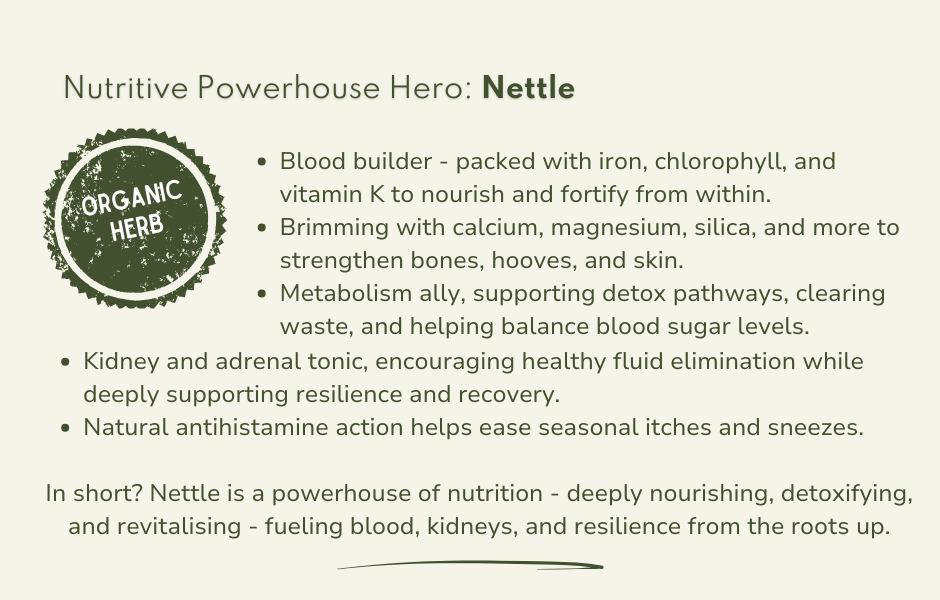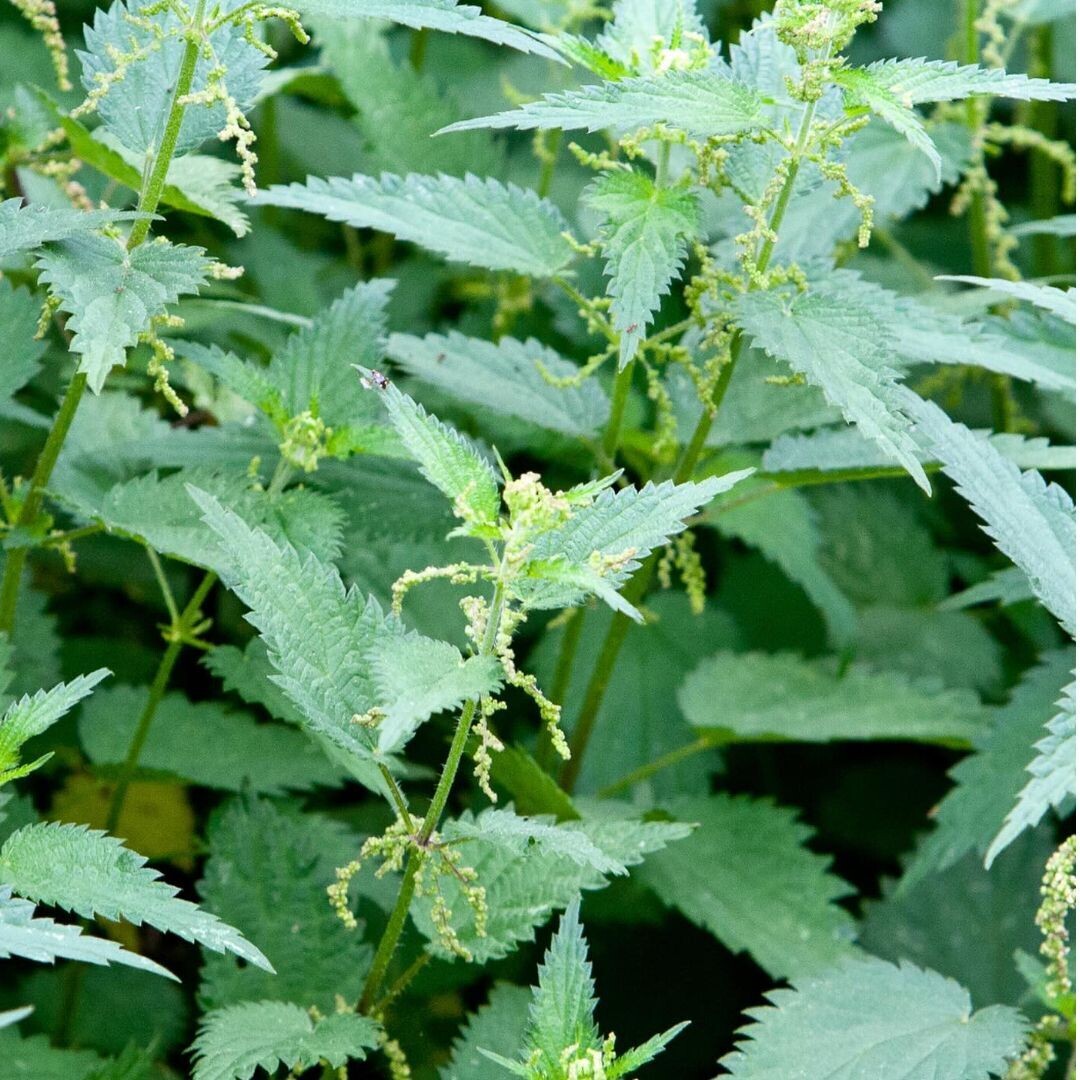NETTLE (Urtica dioica) *Organic herb for horses
Benefits of Organic Nettle Herb for Horses
Rich in iron, minerals, and chlorophyll, nettle is a true nourishing powerhouse - supporting vitality, detox pathways, and resilience from root to leaf.
Please note this is a nutritional, functional horse food supplement and not veterinary medicine. For more on this, see Dr Kellon's Horse Sense - Nutrition is not 'Alternative' Therapy
.

Find Organic Nettle in the EquiNatural range
When it comes to our blends, where don’t we use nettle? It’s fair to say that along with milk thistle it’s up there as one of our proprietary blends that features in just about every one of our blends, including our complete CARE Immunity supplements.
Feed Guide
💧Organic Nettle Leaf Tincture
Our human-grade, certified organic tinctures give you a ready-to-absorb potent source of phytonutrients at the highest-strength available, for immediate absorption straight into the bloodstream and to the body’s cells.
- Urtica dioica Folia (Stinging Nettle)
- Leaf
- Decocted 1:3 35%
- Organic Cultivated
~ Feed Guide - nettle leaf tincture for horses
- 6ml/100kg bodyweight, daily in feed.
- ♻️ Our tinctures come in a heat-sealed, twin-neck, child-resistant HDPE plastic dosing bottle, complete with dosing chamber. *HDPE (High-Density Polyethylene) plastic is 100% recyclable, and energy-efficient to produce. Safe for food/water storage, it reduces waste and emissions while resisting wear. A top sustainable choice to match the EquiNatural ethos.
🌿Organic Dried Nettle Herb
Grown, harvested and dried without the use of agri-chemicals, non-irradiated and GMO free - see our Quality page for Quality Management & Certification Documents.
- Urtica dioica Folia (Stinging Nettle)
- Herb
- Wild Harvested
- Origin Bulgaria
~ Feed Guide - dried nettle herb for horses
- 5g/100kg bodyweight per day, i.e. 25g for a 500kg horse.
- Want a scoop? You can add a scoop to your basket during checkout.
- ♻️Supplied in a 100% fully recylable, resealable, food-grade foil pouch for freshness.
Footnotes
- Laboratory tested for identification and compliance to the British and European Pharmacopoeia standards.
- Human grade.
- Please be aware that if you're purchasing our dried botanicals for human use, our dried range is cut to appropriate sizes for feeding to horses.
- ♻️ Eco Note: Our packaging is recyclable and refillable.
- 🧊 Storage Tip: Keep cool and dry.
Functional Nutritional Value
Constituents: Vitamins A, C, E, and K, riboflavin, thiamine, minerals (calcium, chromium, magnesium, manganese, phosphorus, potassium, silica, iron, and zinc), protein, formic acid, serotonin, acetylcholine, flavonol glycosides (quercetin, kaempferol, and isorhamnetin), and chlorophyll.
Safety
- Nettle is considered highly nutritive and safe.
- Note that in human studies, high internal use may decrease the efficacy of anticoagulant drugs (Hoffmann, 2003).
Nettle in History & Tradition
Nettle. Where do we even start to talk about nettle as a nutrient-rich medicinal? Or rather, what isn’t there to say about nettle? Nettle is just overflowing with nutrients, which is testament to the fact that it grows everywhere other than rough ground, as where it grows is an indicator of good soil quality.
Now before anyone says, “but we’ve got nettle all over our poor-quality turnout fields,” you have, but you also haven’t – nettle won’t grow where a horse hasn’t pooped; it’s the composted poo that has enriched the soil, which is why, if you skip your field poos to a composting poo-pile along the edge of your field, you’ll get a huge bank of nettles. And they’re worth having there, as nettle makes an excellent addition to the compost pile due to its high nitrogen content.
Nettle has been used as a food, herb, and rope fibre for thousands of years, but at the top of the list of nettle’s properties is perhaps being best known for its sting, as we can all no doubt claim. Caused by the formic acid and histamine contained in those tiny hairs that cover the stems and leaves, when we brush against nettle those almost invisible hairs penetrate the skin. They then snap off and release their chemicals.
You’re lucky if the sting doesn’t last long – on some it lingers for hours (including me). But – find some wild plantain or dock, both of which you’ll usually find in your field, macerate it between your fingers to break the fibres and release some juice, and rub it on. Works a treat to calm the sting.
Staying with that sting, there’s also a time-honoured tradition used by many cultures called urtication , which is intentionally stinging yourself to address joint issues such as arthritis or gout. The sting causes strong physical stimulation of nerves and joints, said to activate dormant energies and stimulate circulation, lymphatic flow, and cellular metabolism to clear congestion-causing wastes. The inflammation caused by the nettle sting will subside in a few hours hours, as will the joint pain and stiffness.
Nettle tea is all the rage, and the stalks and leaves can be either juiced, or eaten as a cooked green like spinach – nettle soup was a huge foodie fad a few years back. As for the seeds – which are even more nutritious that the nettle plant itself - they can be eaten directly; they’re fabulously nutritious when infused into an oil.
Nettle’s nourishing and herbal action is attributed to its rich vitamin, mineral, amino acid, and chlorophyll content, as well as formic acid. It contains abundant calcium, magnesium, silica, iron and vitamins A, C, E, and K, as well as several other minerals. The high mineral and chlorophyll content gives nettle a salty, swampy taste slightly reminiscent of seaweed, which could be why I actually can’t tolerate the taste of nettle tea – to me it tastes like rotting carcass, but I hope me saying that won't put you off trying it! Hence why I personally take my nettle in tincture form.
Energetically, nettle is cooling and drying and is astringent due to its tannin content. It’s a valuable herbal tonic, and can be drunk or eaten daily. It nourishes, supports, and energises the whole body, and is richly nourishing to the blood. Chlorophyll and red blood cells were made for each other – they have a near-identical molecular structure; the only difference is that chlorophyll contains magnesium whereas haemoglobin has iron. The rich 'green' taste of nettle shouts ‘nutrition’, and the salty taste and iron content hints at its use for building the blood, supporting convalescence after illness and balancing anaemia.
Nettle is also an alterative that helps to detoxify the body and is useful as a spring tonic after a long winter, hence why it features in all our Immune CARE blends.
Nettle also has the added benefit of helping to maintain balanced blood sugar levels; research indicates that nettle contains both hypoglycemic and hyperglycemic constituents. In a clinical trial (Kianbakht et al., 2013), nettle leaf extract was found to improve glycemic control in patients with type 2 diabetes who require insulin therapy; just one of many reasons why we include it as a proprietary herb in both our CushTonic blends and MetaTonic.
Nettle is also a renowned alterative, meaning it purifies the blood and assists the body in nutrient and protein assimilation, neutralisation of acid, and elimination of waste. As such, it can be used for metabolic disorders by detoxifying the body of metabolic wastes. Nettle also stimulates the kidneys to increase excretion of uric acid, which aids in easing arthritis.
To list all of the symptoms that nettle can relieve would take forever so we’ll snapshot it here:
- Nettle’s diuretic actions are strengthening for the kidneys and genitourinary system, helping to flush the urinary system and remove toxins.
- Nettle is a deeply nourishing tonic for the adrenals. The seed is said to strengthen the adrenal glands and provide energy during times of fatigue or stress.
- Nettle can be useful in cases of hay fever, asthma, and seasonal allergies due to its anti-inflammatory and antihistamine actions (why we use it in our PollenTonic).
- Nettle is suggested for use during pregnancy and lactation, and not just for its nutritive qualities. As a galactagogue, nettle increases the quality and quantity of breast milk.
- Infused nettle leaf applied as a hair rinse is said to create thick, glossy, vibrant hair and lustrous smooth skin. Pour a mug of nettle tea into your rinse bucket next time you bath your horse ;-)
Nettle trivia
Did you know? Back in the day nettles were cultivated as a commercial fibre plant in Europe, used to make cordage, fishing lines and sailcloth, as well as cloth and paper. Thread made from nettle is said to be 50 times stronger than cotton.


